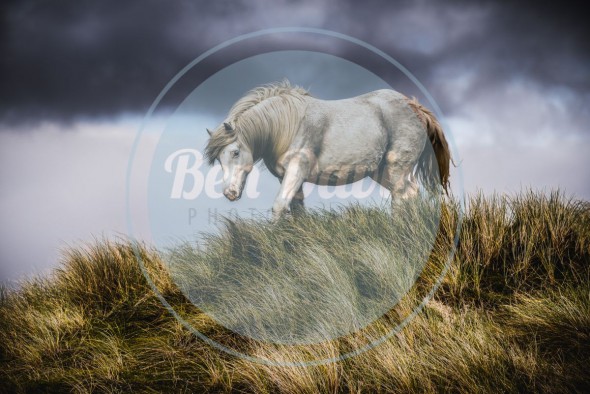You might want to protect your images online, but Ben Davis reckons watermarking isn’t the way to do it. Here’s why, and what you should do instead

"At best distracting, at worst hideously ugly." All images (and watermarks) by Ben Davis
Aside from selective colouring, adding a watermark is the quickest way to ruin any photograph.
No image has ever been improved by the presence of a watermark. At best they are distracting, and at worst they are hideously ugly. Granted, you get the odd one which is fairly stylish and not totally regrettable, but I find the vast majority are ghastly.
It simply ruins the picture. Anything that leads the eye away from the main subject shouldn’t be there, particularly if you’re posting your photos for pleasure and hoping that others will enjoy them too. You’ve probably invested lots of time and energy in capturing an image and perfecting it in post-processing, so why go and spoil it by slapping a watermark on it?
I understand the valid arguments for wanting to protect your work from theft and unauthorised use, but the fact of the matter is that watermarks don’t work.
You have two options for positioning a watermark, neither of them good. Placing a watermark so that it obscures the subject will certainly put people off from pinching your shot, but it’s a bit like trying to deter car thieves by pre-emptively smashing in your own windscreen. It just doesn’t make sense.
A subtle watermark, discreetly placed in the corner, is much less offensive, but equally is much less effective at stopping the image from being stolen. If someone really wanted to take the image, they could easily crop the watermark out, so it might as well not be there in the first place.
Even the large, obnoxious watermarks plastered across the centre of images can usually be removed in Photoshop if a thief is determined enough. Or people may decide to use the image anyway with the watermark still intact. Watermarks don’t prevent theft. Nothing can.

Defenders of the watermark will cite other supposed benefits. They’ll say watermarks are good for marketing, as they help promote a photographer’s brand to potential clients. Well, if I’m looking at someone’s work, the vast majority of the time it’ll be on one of their own channels – their website, Facebook, Flickr or Instagram. I know who the author is: it says it right there on the page. In my opinion, there’s no need to sully the image with an extra bit of self-promotion.
I’ll concede that if an image gets shared or duplicated then there are some positives to exposing your brand to a wider audience. But realistically, how much extra income or admiration do you think that watermark will bring? Most working photographers pick up new clients via referral. I’ve never heard of anyone getting work because someone saw their watermark.
Watermarking can even be detrimental to your marketing. People may be less likely to share something that’s watermarked, and for my part, I’m less inclined to click “Like” if I’m annoyed by an obstructive branding attempt that impairs the image.
Some photographers will even argue that adding a watermark adds a professional element to the frame, differentiating it from one belonging to a carefree amateur. But how many top professional photographers do you see watermarking their images? I can’t think of one. If anything, a watermark can make you look less professional, especially if your logo is a bit naff or your name is written a crude font. Many of them are.
On some level, I also think a watermark makes you look somewhat paranoid and precious, like those people who write their name on their lunch in the work fridge. It might seem like a fairly innocuous way to deter people from stealing it, but trust me, you’re doing yourself no favours. And, again, someone still might take it anyway.

So what to do instead?
It’s almost inevitable that at some point someone will take your images without your permission. There are, however, a number of ways you can protect your photographs without desecrating them.
To start with, you should only ever upload low-resolution files to the Internet. In most circumstances, an image that measures 1000 pixels wide is plenty big enough for online purposes while still being far too small to make any kind of worthwhile print. A full-size file has much more value to a would-be thief, as more can be done with it. Uploading larger images is pointless anyway, as neither web browsers nor most computer screens are capable of rendering them. Social media platforms will compress your pictures to optimise them for their site and servers anyway.
Some websites will allow you to protect your images by disabling the right-click mouse option, which means you can’t select and save the image. I have this feature enabled on my own websites. If someone really wants to copy the pic then they can still take a screenshot of it, but this reduces the resolution even further, making it no use for commercial purposes.
You should also include EXIF (Exchangeable Image File Format) data embedded in your images. This is easy to add, either in camera or in post-processing software like Photoshop or Lightroom. EXIF data serves as a kind of certificate accompanying the image, with information about the content creator, copyright holder and their contact details, alongside the camera settings.
Ensuring your contact details are embedded within the image is essential if you have any interest in ever making a potential sale from the work. That way, if someone does want to buy a license to use it, they have the opportunity to ask rather than just take it and claim ignorance.
EXIF data can be removed though, and so some photographers more concerned with better online protection opt for services like Digimarc, which offers an imperceptible identifier to an image that survives file-format changes, editing and cropping, and stays embedded wherever it goes. Subscribers to the Professional service package benefit from Digimarc crawling the public web and searching for images with your identifier, so you can then take action against any infringements.

This last feature is also something you can do yourself, for free. It’s easy to search the web for duplicates of your images – in Google Chrome, simply right-click and select “Search Google for Image”. The results will bring up Google’s suggestions of visually similar images, and should also reveal pages where your exact image is hosted. It doesn’t work for images posted privately – say on Facebook – but it does search for public pages.
Try it on some of your own images, especially ones you know that do appear elsewhere on the web. If you find your work used without your permission, you can then contact the site owner to inform them of the infringement and go about seeking recompense, if you’re so inclined.
If your work is taken and used for any commercial purposes without your consent, then you’re entitled to be upset and go about seeking payment. If this does happen, contact the publisher, informing them of their infringement and supplying an invoice for the use of the image. In most circumstances you’ll find they are apologetic and happy to pay.
I was once even contacted out of the blue by a magazine in Kazakhstan, apologising because they’d published my images without my permission and offering to pay for their usage. This was a welcome bonus, and the images would never have been published in the first place if I’d laid a watermark over them.
A final thought. Do you ever cringe when you look back at some of your work from five or ten years ago? I do. We all grow and develop as photographers, perfecting techniques and crafting styles as the years go on.
While I’m still proud of the work I did in my early career it certainly isn’t representative of my photography now. Had I watermarked those images they’d be forever associated with me upon instant viewing, when in reality I’ve orphaned them long ago as I progressed.
I’m sure that one day I’ll want to move on from the work I’m producing now, and I’m not going to let an ugly and ineffective watermark hold me back.
Do you agree with Ben? Join the conversation on Facebook
About the Author

Ben Davis is an award-winning professional photographer with more than 10 years' experience in the industry. His internet home is www.cambridgeshireweddingphotography.com

